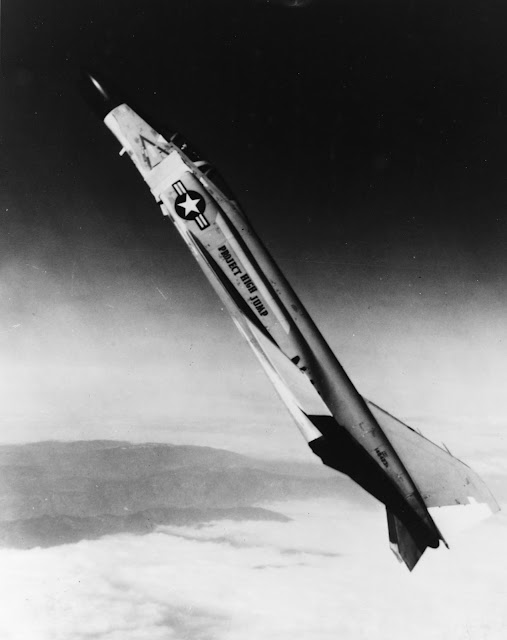BuNo 148423: note what appears to be a high-visibility rectangle above the Project High Jump marking.
All of the F4H Phantom II's speed and altitude records were set by F4H-1Fs, which were originally designated F4H-1 and then redesignated F-4A. The time-to-climb records were set in early 1962 in Project High Jump with F4H-1 (subsequently F-4B) BuNo 148423, the 108th Phantom II. These were timed from a standing start to the following altitudes in meters above the takeoff point:
Altitude Time (seconds) Pilot
3,000 34.123 LCDR John W. Young, USN
6,000 48.797 CDR David M.Longton, USN
9,000 61.688 LtCol W.C. McGraw, USMC
12,000 77.143 LtCol W.C. McGraw, USMC
15,000 114.148 LCDR D. W. Nordberg, USN
20,000 178.5 LCDR Francis T. Brown, USN
25,000 230.44 LCDR John W. Young, USN
30,000 371.43 LCDR D. W. Nordberg, USN
On the 30,000 meter record flight, the F4H coasted past 100,000 feet, unofficially breaking the altitude record.
The time-to-climb records were accomplished at two different locations with a separate flight (and usually more than one attempt) for each altitude using the flight profile that minimized the time and fuel required. The climbs up to 15,000 meters were flown out of NAS Brunswick, Maine to take advantage of cooler air; the 20,000 meter and above flights were accomplished beginning at sea level from NAS Point Mugu, California.
The takeoff from Point Mugu was initiated using the catapult holdback to restrain the aircraft while burning down to the minimum fuel required and then releasing the holdback electrically. The profile was to accelerate to 400 knots, climb to 40,000 feet, accelerate to 2.1 Mach, and then pull up to the optimum attitude to achieve the target altitude in minimum time.
There has been some confusion about there being a second Phantom used, BuNo 149449, because it was marked with the Project High Jump logo, apparently for PR photos. However, it had only made its first flight at St. Louis while the last record flights were being accomplished at Point Mugu with 148423. As near as I can tell, however, the markings are virtually identical in font and location to the ones on 148423, which leads me to believe that they were both applied by McDonnell since it appears to be flying over Missouri.
The pilots at Brunswick, left to right, LCDR Young, CDR Longton, LtCol McGraw, and LCDR Nordberg:
The pilots at Pt Mugu (note the full-pressure suits required):
Thanks to my F4H subject-matter expert, Peter Greengrass, for photos and corrections.






No comments:
Post a Comment